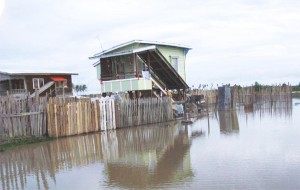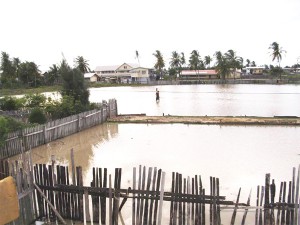Rainfall over the past week or so has left parts of the Corentyne flooded, in some areas the water is knee-high and some villagers have lost livestock.
Stabroek News visited a few of the affected areas yesterday.

In the southern part of Manchester Village, commonly known as “Building”, the flood water was as high as one’s knees. Donald Morgan, a farmer, of Lot 13 Second Street, Manchester, who rears sheep, goats, pigs and other livestock, told Stabroek News that he had lost Creole fowls, goats and sheep. He also plans on selling some that may have been affected by the floodwater. Morgan said he would normally keep his livestock in his yard, but the entire yard has been flooded for just under a week and the animals are finding it difficult to survive. Besides, Morgan said, there was dung in the yard and he felt he and his family were at risk for contracting diseases.

Morgan opined that the authorities have not done enough to help the situation. He said the street had been rehabilitated about 18 months ago by the Lancaster-Hogstye Neighbourhood Democratic Council, but added that if the drains at the sides of the street were dug properly, less water would have been on the land. As it is, he said, the water is not moving.
Some houses in Manchester were surrounded by water as high as 45 cm. Pit latrines and all other outdoor facilities were submerged in this water. Health workers have visited other flood affected areas on the Corentyne and treated persons for water-borne diseases, but the villagers said they had not been visited. They said mosquitoes and flies had infested their homes and they also have to attach a hose to the submerged pipeline to obtain drinking water, which they feel is unhealthy. But they cannot afford to do better.
Sulvan Allen of Manchester Village is severely affected. His livestock are finding it difficult to cope with even as he and his family are trying to protect themselves. They said that they are helpless against such disasters, but if “the people in local authority” were doing their part this would not have happened.
There is a drainage canal located between Manchester Village and Liverpool Village and although the koker door is open, the water is still not leaving the land. Stabroek News visited the site yesterday morning around 7 am and found that the water was flowing at a moderate speed.
There is a drainage pump installed there but it was not being operated at the time. Some rice farmers whom this reporter met on the way said the pump could have been used to help drain the area faster.
They also said they felt that because of the way the drainage canal was constructed, it would be blocked very quickly. One of the farmers told Stabroek News that years ago the canal was in a “slant” and not running straight into the sea. He said that because it is now running straight into the sea “sling mud goh come in easy and block up ah koker.”
A hymac was at the koker a few days ago trying to clear the mud, but this rice farmer, who is also a hymac/dragline operator, feels that the hymac can only scrape the corners as “them boom nah long enough. So wha dem do deh ah waste time.”
At the present rate of drainage, he said, the water will remain on the land for at least another week, “and if more rain deh fuh come, worst yet.”
This canal drains water from Hogstye to Lancaster, which includes the housing area as well as the backlands, and because the water in the backdam is higher and stretches for miles, it will take a while, he said.




